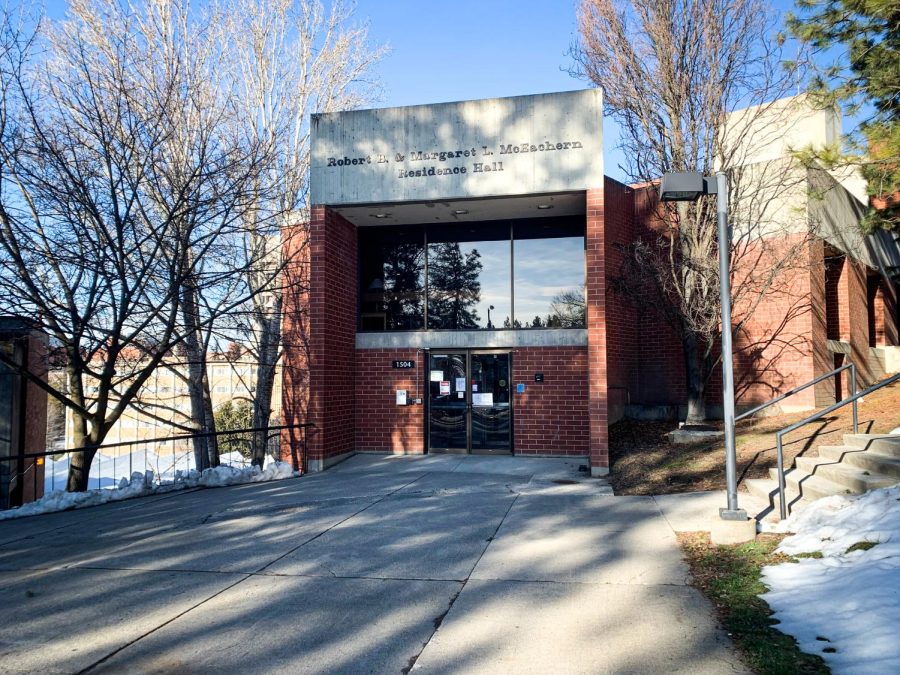WSU houses COVID-19-positive students in McEachern Hall
Rooms have bathroom, refrigerator, microwave; food delivered from Southside Café
Students living on campus who test positive for COVID-19 are sequestered in McEachern Hall for quarantine.
January 17, 2022
McEachern Hall is continuing to house students who have contracted COVID-19. If a student contracts COVID-19, there are processes in place to keep the WSU community safe.
First, there are a variety of ways someone can get a COVID-19 test. This includes the testing site at Cougar Health Services, home rapid tests from a store, and other community sites, said Jill Creighton, associate vice president of Student Affairs, Dean of Students and deputy Title IX coordinator.
If someone who lives on campus tests positive for COVID-19, they need to call WSU Environmental Health and Safety, who will help set students up in the sequester location, Creighton said.
Sophomore psychology major Kaylee Dressler received a positive COVID-19 test in March 2021 when she was living in the dorms on campus.
“I got pretty sick, so I called Cougar Health, and Cougar Health told me that I needed to come get a COVID-19 test. I went and got a COVID-19 test, and it tested positive, ” Dressler said.
CHS emailed Dressler her positive test notification and included a number for her to call to take the next steps, she said.
She went back to her dorm to call the number, but no one answered. It was difficult to contact them, so she left a message, she said. During all of this, she continued to stay in her dorm room.
After one or two days, Environmental Health and Safety did call her back and provided information about moving into the quarantine hall, Dressler said.
McEachern is the sequester hall because everyone can get their own room, there is direct outdoor access from the rooms and students can have up to one bathroom mate, Creighton said.
Environmental Health and Safety will provide more information about what students should bring to McEachern. This should include all basic items a student needs while living there for a couple of days, she said.
Students do not need a vehicle to get to the sequester hall, Creighton said. If a student has a private vehicle, they can use that. If not, students will get transported to McEachern Hall safely.
When Dressler arrived at the quarantine hall, a key was under a doormat for her.
Each room has a bathroom that could potentially be shared with one other person, a microwave and a refrigerator, Creighton said.
“I called it the prison,” Dressler said. “It was like you were trapped in your own little box, and it was brick.”
While students are in the sequester hall, they can get meals delivered to them, Creighton said. There is a section specifically for those living in McEachern on the GET Mobile app. Dietary restrictions and food allergies can be accommodated. Students can use outside delivery services if wanted.
All of the food provided is through Southside Café, Dressler said. The food comes on a special schedule. Breakfast had to be ordered the night before and staff would drop the food off around 7:30 a.m. to the exterior door. Because of the food being outside, raccoons got into her food.
Environmental Health and Safety never told Dressler when she could leave the quarantine hall. She was under the impression that they would call her when she could check out from McEachern, but they never did.
She called the Environmental Health and Safety number, but nobody responded. At that point, Dressler left a message saying she received a negative test and she was packing up to go back to her dorm room.
No one monitors health while at the sequester hall. Students should be monitoring their health in conjunction with what their medical provider tells them, Creighton said. This is a housing option, not a hospital.
“It’s not the Four Seasons, and I think that’s important for people to remember, but it is a safe and warm place with internet access, where people can recover,” she said.










